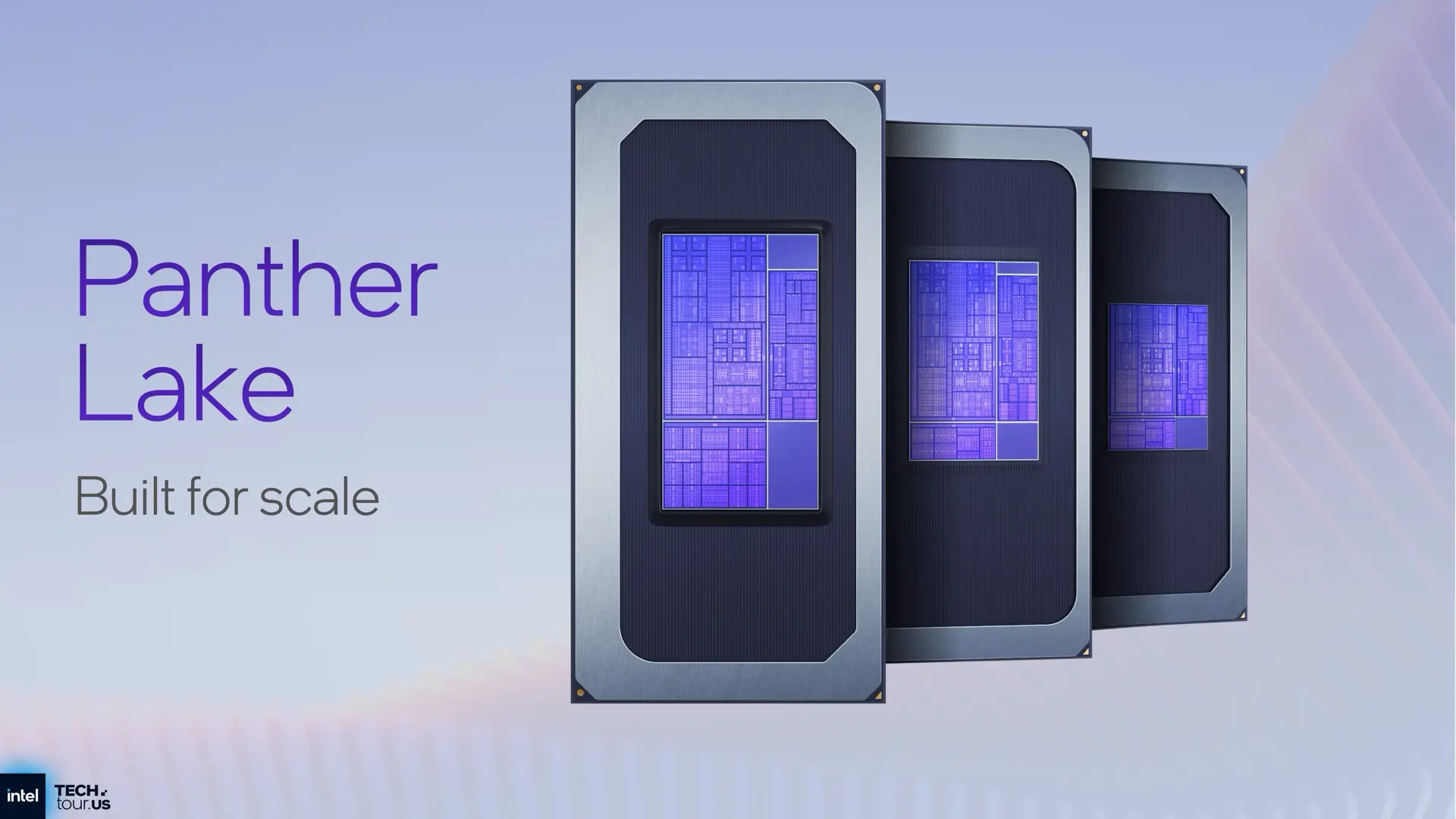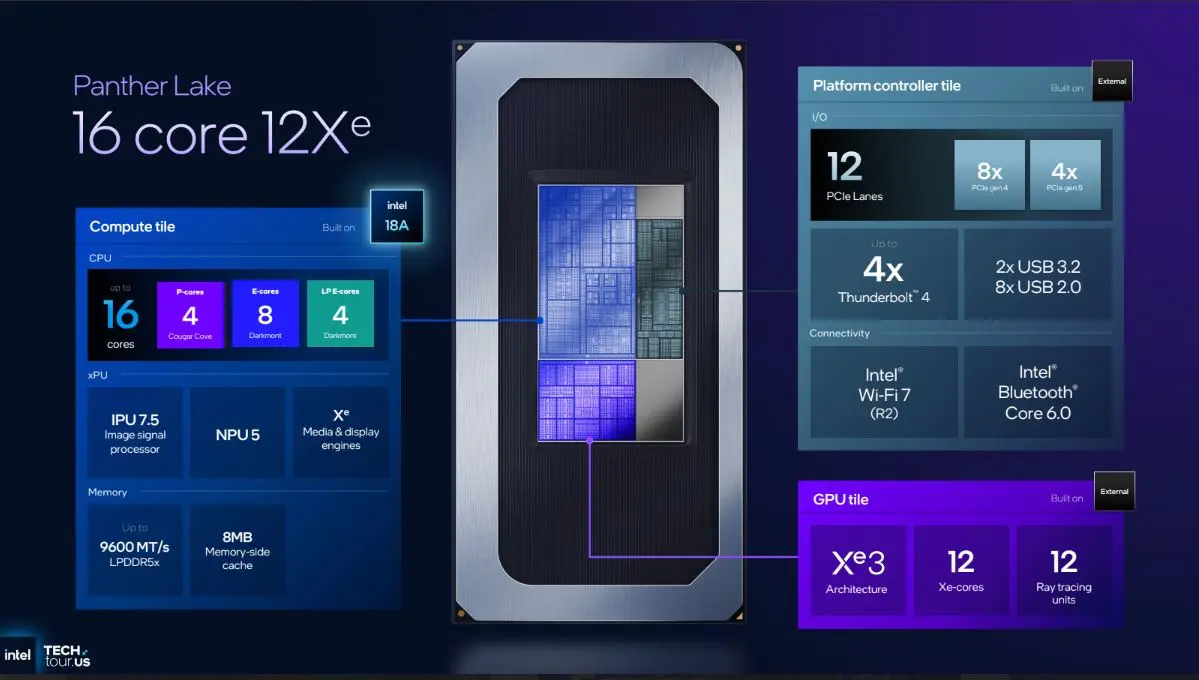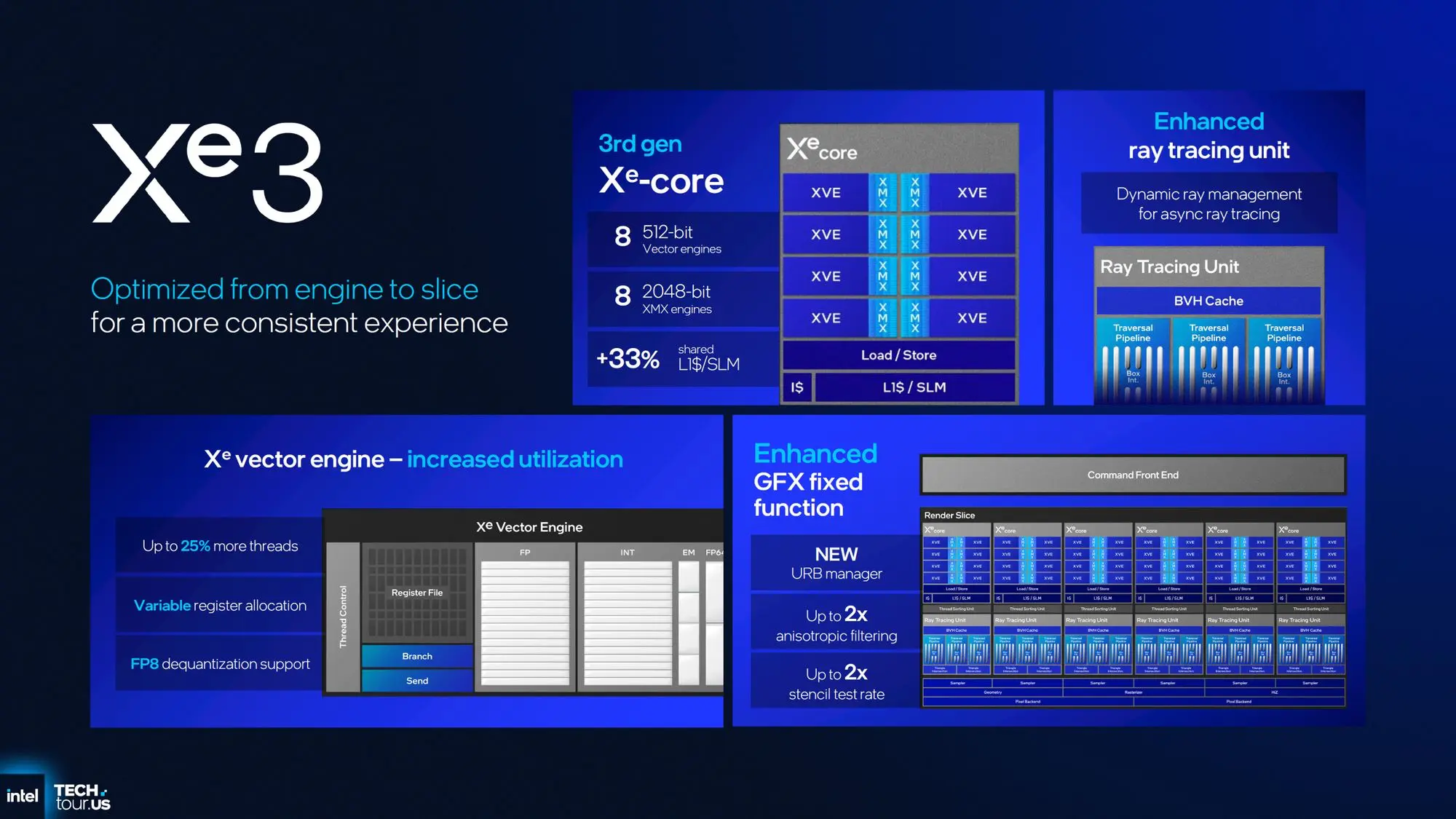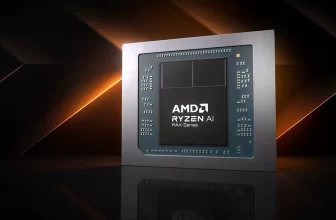
Intel has officially taken the wraps off its upcoming Panther Lake mobile processors, and as we suspected they would, they’re bringing some serious firepower to the integrated graphics game. Built on Intel’s cutting-edge 18A process node and featuring the new Xe3 graphics architecture, these chips promise to greatly improve power efficiency and performance – especially in the iGPU department.
The Great Unifier

If you’ve been following Intel’s recent laptop CPU releases, you might have noticed things getting a bit… complicated. Lunar Lake offered exceptional battery life but limited configuration options for laptop makers. Arrow Lake-H delivered performance and flexibility but couldn’t quite match Lunar Lake’s efficiency. Panther Lake aims to be the best of both worlds, and judging by Intel’s claims, they might actually pull it off.
The new processors will come in three distinct configurations: an entry-level 8-core chip with 4 Xe3 graphics cores, a mid-range 16-core chip also with 4 graphics cores, and a flagship 16-core processor packing a hefty 12 Xe3 cores. That top-tier configuration is where things get really interesting for anyone who cares about integrated graphics performance.
Xe3: Not Celestial, But Still Impressive

Before we dive into the numbers, let’s clear something up: despite the name suggesting otherwise, Xe3 is not based on Intel’s previously announced Celestial architecture. Intel classifies it as part of the Battlemage family because its software-facing capabilities are similar to existing Xe2 products. The company admits the naming isn’t ideal, but here we are.
What Xe3 really is, is an evolution of the Xe2 architecture that debuted in Lunar Lake. Intel focused on two main pain points: better resource utilization and improved scalability. And they’ve made some pretty clever architectural changes to get there.
Under the Hood
Each Xe3 core maintains the same basic structure as Xe2: eight vector engines for math operations, eight XMX engines for AI acceleration, and one ray-tracing unit. But the devil’s in the details, and Intel has made several important tweaks.
For starters, each Xe3 core can now keep up to 25% more threads in flight compared to its predecessor, jumping from eight to ten. More importantly, the architecture introduces variable register allocation, allowing each core to dynamically partition register files per thread. Intel calls this a “dramatic” improvement for performance, and based on their microbenchmarks, they’re not exaggerating.
The shared local memory per core has also grown from 192KB in Lunar Lake’s Xe2 to 256KB in Xe3. This brings integrated Xe3 GPUs in line with what Intel’s discrete Arc B580 and B570 cards already offered, and it addresses a major performance bottleneck that plagued earlier Arc integrated graphics.
Cache Money
Perhaps the most striking change comes further out in the cache hierarchy. The flagship 12-core Xe3 configuration boasts a massive 16MB of shared L2 cache—double what Lunar Lake offered with its 8-core setup. To put that in perspective, Intel’s discrete Arc B580, which has 67% more graphics cores, only packs 12.5% more L2 cache at 18MB.
Why does this matter? For an integrated GPU that shares system memory with the CPU and NPU, a larger L2 cache means less traffic competing for access to RAM. Intel claims this results in a 17% to 36% reduction in fabric traffic compared to an 8MB baseline, which should translate to more consistent performance and lower power consumption.
Performance Promises
Now for the part everyone cares about: how fast is it actually going to be?
Intel is claiming that the 12-core Xe3 GPU delivers more than 50% better overall performance than Lunar Lake’s integrated graphics at similar power levels. If you’re willing to feed it more power, the performance gains can stretch even further. Against Arrow Lake-H’s older Xe-LPG graphics, Intel claims better than 40% improvement in performance-per-watt.
In Intel’s internal microbenchmarks, certain operations show some truly impressive gains. Depth testing, a fundamental part of any modern rendering pipeline, saw speedups ranging from 1.9x to an eye-popping 7.4x. Ray-triangle intersection tests, anisotropic filtering, and mesh rendering all demonstrated at least 2x improvements over Xe2.
For shader operations that put heavy pressure on registers (which, let’s be honest, is most of them), the new variable register allocation can deliver between 1.9x and 3.1x faster performance.
XeSS Multi Frame Generation
Intel isn’t just relying on raw hardware improvements, though. The company is bringing AI-powered Multi Frame Generation to its XeSS upscaling technology. Similar to NVIDIA’s DLSS Multi-Frame Generation, XeSS MFG will offer 2x, 3x, and 4x modes that generate one, two, or three frames between each rendered frame.
The good news? Any game that already supports XeSS 2 frame generation will work with the multi-frame version through a simple toggle in Intel’s graphics control panel—no game updates required. Early hands-on impressions suggest the image quality is solid, though input lag in faster-paced games might require some tweaking of settings to find the sweet spot.
The Competition Context
Where does this leave Panther Lake’s graphics compared to the competition? Intel is clearly targeting the gap between basic integrated graphics and entry-level discrete GPUs. The 12-core Xe3 configuration, in particular, seems designed to make budget gaming laptops and handheld devices genuinely viable without requiring a separate graphics chip.
For context, Lunar Lake’s 8-core Xe2 GPU already delivered respectable 1080p gaming performance in less demanding titles. A 50% performance boost would put the flagship Panther Lake configuration in the ballpark of entry-level discrete GPUs from a generation or two ago. Not exactly setting the world on fire, but potentially good enough for 1080p gaming at medium settings in many modern titles.
AMD’s upcoming integrated graphics solutions will likely remain the primary competition, especially given their historical strength in this area. Qualcomm’s Snapdragon X Elite chips and Apple’s M-series chips are strong as far as efficiency goes, but they play in their own ecosystem (especially Apple).
Three Flavors of Panther Lake
As mentioned earlier, Intel is dividing Panther Lake into three main segments, and the choice of graphics configuration plays a big role in determining which SKU goes where.
The entry-level 8-core chip (4 P-cores and 4 low-power E-cores) with 4 Xe3 cores targets lightweight laptops where battery life trumps performance. It supports up to DDR5-6400 or LPDDR5X-6800 memory and offers 12 PCIe lanes.
The mid-range 16-core option (4 P-cores, 8 E-cores, and 4 low-power E-cores) also gets 4 Xe3 cores but compensates with more CPU power and better I/O. It supports faster memory (DDR5-7200 or LPDDR5X-8533) and packs 20 PCIe lanes, making it suitable for pairing with discrete graphics cards in gaming laptops.
The flagship 16-core chip with 12 Xe3 cores is restricted to LPDDR5X memory only, supporting blistering speeds up to 9600 MT/s. This memory limitation—and the return to just 12 PCIe lanes—makes it clear Intel is targeting handheld gaming devices and thin ultrabooks where the integrated graphics are expected to do all the heavy lifting.
CPU and Efficiency Gains
While we’re focused on graphics here, it’s worth noting that the CPU side of Panther Lake looks solid too. The new Cougar Cove P-cores and Darkmont E-cores promise 10% better single-threaded performance and over 50% better multi-threaded performance compared to Lunar Lake at similar power levels. Against Arrow Lake-H, Intel claims 30% lower power consumption for similar multi-threaded performance.
The chips also feature Intel’s fifth-generation NPU, which delivers 50 TOPS of AI performance (up from 48 in Lunar Lake) while taking up 40% less die area. Combined with the GPU’s AI capabilities, total system AI performance can theoretically hit 180 TOPS.
When Can You Get One?
Intel says the first Panther Lake processors will ship before the end of 2025, with broad availability expected starting in January 2026. We’ll likely see the official product announcements at CES 2026, where Intel typically reveals the nitty-gritty details like specific SKU names, clock speeds, and pricing.






